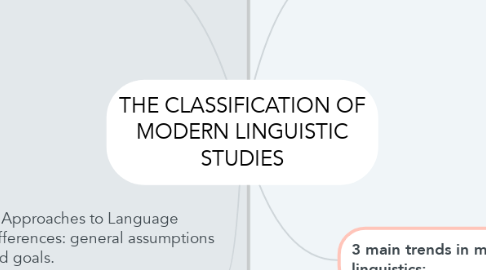
1. Branches of Linguistics: applied linguistics, cognitive linguistics, contact linguistics, corpus linguistics, discourse analysis, forensic linguistics, graphology, historical linguistics, language acquisition, lexicology, linguistic anthropology, neurolinguistics, paralinguistics, pragmatics, psycholinguistics, sociolinguistics, and stylistics.
2. Approaches to Language Differences: general assumptions and goals.
2.1. Traditional Grammar
2.1.1. knowledge of language taken for granted
2.1.2. exhaustive account (description) of “facts”
2.1.3. multiplicity of categories and concepts
2.1.4. no insistence on rigorous consistency
2.2. Structuralism
2.2.1. knowledge of language taken for granted
2.2.2. taxonomy of structural patterns
2.2.3. empiricism & behaviorism
2.2.4. “discovery procedures”
2.3. Generative Linguistics
2.3.1. knowledge of language: mental grammar
2.3.2. language acquisition,creativity of language
2.3.3. parsimony,rigorously consistent
2.4. Cognitive Linguistics
2.4.1. conceptual and linguistic metaphors
2.4.2. cognitive schemata
3. Branches of Linguistics Distinguished in terms of:
3.1. Aspects of language
3.2. Levels of analysis
3.3. Commitment to general assumptions
3.4. Interdisciplinary problems and goals
4. 3 main trends in modern linguistics:
4.1. generative linguistics
4.1.1. what and why is generated
4.1.2. a creative characteristic of the language human activity
4.2. cognitive linguistics
4.2.1. language and thinking ratio, cognition
4.2.2. word and thought
4.2.3. what we use when think
4.3. functional linguistics
4.3.1. functional grammar
4.3.2. the function of the language elements in the process of communication

